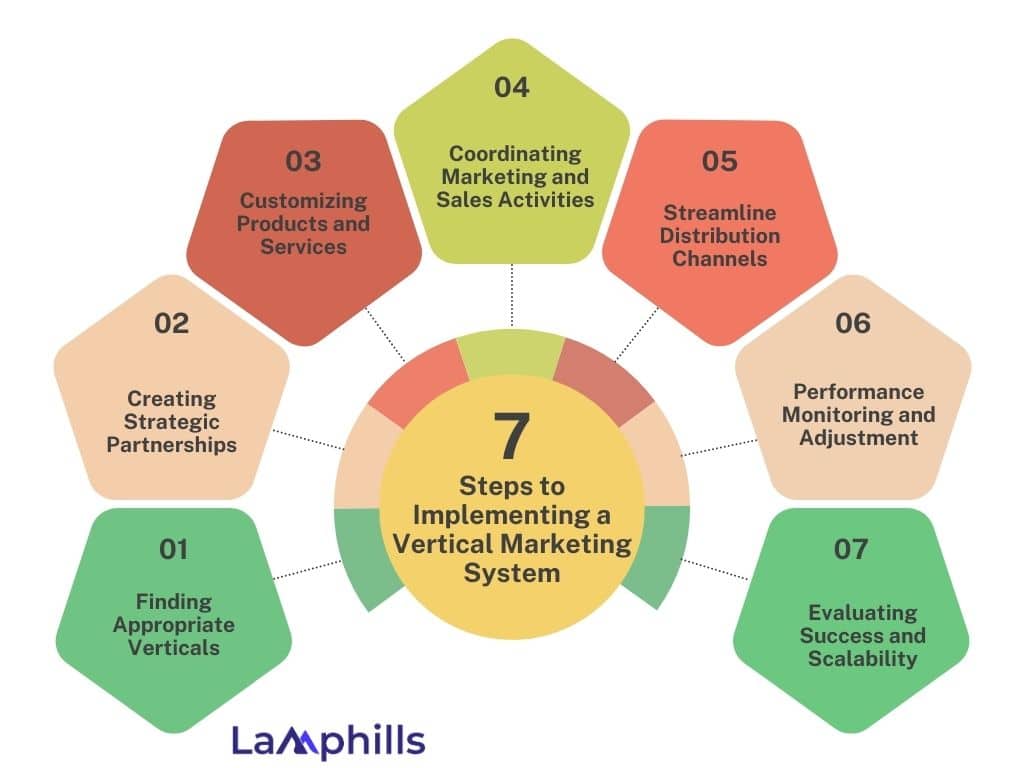When I first started researching the marketing world, I felt like I was just tossing out ideas in the hopes that one of them would stick. It appeared like a random shot in the dark, attempting to appeal to everyone but failing to reach anyone. That all changed when I discovered vertical marketing. This tactic was analogous to going from a scattergun approach to a precise, focused laser beam. So, how does this system work and how can you utilize it to drive hyper-focused growth in your own business? Here, I’d like to share this effective method with you—the secret vertical marketing system that has resulted in great growth and clarity in how I target and win clients.
What is a Vertical Marketing System?
A Vertical Marketing System (VMS) is a structured technique in which the key components of a distribution channel—the producer, wholesaler, and retailer—collaborate in a single system to meet consumer needs more effectively and efficiently. Unlike traditional marketing systems, which function individually, a VMS establishes a synergistic group that is professionally managed and centralized. This system intends to improve channel efficiency and marketing impact by decreasing channel disputes, streamlining distribution, and increasing overall profitability.
According to a recent survey conducted by The Balance Small Business, organizations that use Vertical Marketing Systems experience a 30% increase in client acquisition and a 20% increase in customer lifetime value.
Key Takeaways
- A Vertical Marketing System involves collaboration among all elements of the distribution channel—producers, wholesalers, and retailers—to enhance efficiency and marketing impact.
- There are three types of VMS: Corporate VMS, where one owner controls all phases; Administered VMS, coordinated through influence without ownership; and Contractual VMS, involving contracts among independent businesses at different stages.
- Utilizing a VMS can lead to improved efficiency by streamlining operations, greater control over the supply chain, enhanced competitive advantage, and cost reduction.
- Despite its benefits, a VMS can be complex to manage and may reduce flexibility. The article discusses steps for implementing VMS, including identifying suitable verticals, forming strategic partnerships, and customizing products to meet specific market needs.
What is the Difference Between Vertical and Horizontal Marketing?
A vertical market is one in which vendors provide goods and services tailored to a single industry, trade, profession, or other set of clients with specialized requirements. A horizontal market is one in which a product or service fits the needs of a diverse set of purchasers from many sectors of the economy.
How a Vertical Marketing System Works
Vertical marketing systems are classified into three groups based on how they link the production and distribution processes:
#1. Corporate VMS
In a Corporate Vertical Marketing System, a single owner oversees all stages of manufacturing and distribution. This type could include a manufacturer that has its own retail stores or a retailer that owns its own production facilities.
Consider an electronics firm that makes and sells its items directly through its own branded storefronts.
#2. Administered Vertical Marketing System
Administered VMS coordinates production and distribution stages based on the size and influence of a single channel member, rather than ownership. Typically, a significant merchant or producer employs contractual agreements or sheer scale to coordinate its actions.
A popular retailer, such as Walmart, can dictate conditions to smaller suppliers due to its large purchase volume.
#3. Contractual Vertical Marketing System
Contractual VMS refers to the collaboration of independent enterprises at various production and distribution stages to maximize marketing impact at a lower cost. This system consists of wholesaler-sponsored voluntary chains, retailer cooperatives, and franchising.
For example, in a franchise operation such as McDonald’s or Subway, the franchisor gives the franchisee a brand and extensive system in exchange for contractual adherence to business practices.
Benefits of Vertical Marketing Systems
Let’s delve deeper into the benefits of a Vertical Marketing System (VMS) and how it enhances business operations:
#1. Improved efficiency:
A Vertical Marketing System streamlines operations by coordinating all phases of the distribution channel to achieve similar goals. This alignment lowers operational bottlenecks and duplicative activities, resulting in a more efficient flow of goods and information. When manufacturers, wholesalers, and retailers collaborate, each stage of the product journey is optimized for speed and accuracy.
For example, in the fashion industry, a VMS can coordinate the efforts of fabric suppliers, garment makers, and retail outlets, ensuring that new fashions reach the market promptly and in reaction to current trends, lowering lead times and responding faster to market demands.
#2. Control Over the Supply Chain
By integrating multiple levels of the supply chain, businesses gain greater direct control over each stage of the process, from raw materials to final sales. This control promotes consistency in product quality and availability. It also allows businesses to implement standards and procedures that are consistent with their brand’s values and quality expectations.
For example, a food company may utilize a VMS to ensure that all materials sourced for their goods match certain organic and non-GMO criteria, hence ensuring product integrity and consumer trust.
#3. Enhanced Competitive Advantage
A VMS enables firms to maintain a consistent brand identity across all customer touchpoints, which is critical for standing out in competitive markets. This system also allows firms to conduct more targeted and effective marketing tactics that are suited to the requirements and tastes of their target market, as opposed to generic efforts that may not resonate as well.
For example, a tech business that specializes in educational software can utilize a VMS to tailor its goods and marketing efforts directly to educational institutions, rather than a larger and less targeted audience, establishing itself as a leader in educational technology solutions.
#4. Cost reduction:
Integrating supply chain activities into a VMS frequently results in significant cost reductions. These savings result from fewer intermediaries, bulk purchasing, and more efficient shipping. When the production and distribution processes are streamlined and managed under a single management system, economies of scale are more easily attained.
For example, an automotive manufacturer that integrates its components suppliers into a VMS can negotiate better bulk material pricing and simplify logistics to cut transportation expenses, hence lowering overall manufacturing costs and increasing profit margins.
According to a HubSpot study from 2022, organizations that used a vertical marketing approach had a 150% boost in return on marketing investment compared to those that used more generic techniques. Another Marketo analysis found that vertical-specific landing pages outperformed generic pages by more than 200% in visitor-to-lead conversion rates. This hyper-focused approach enables businesses to become industry experts, greatly increasing reputation and customer confidence.
Common Challenges of Implementing a Vertical Marketing System
- Complex Management: Managing a VMS can be difficult because of the cooperation required among various components of the supply chain.
- Loss of Flexibility: Companies may become trapped in certain positions within the channel, decreasing their ability to respond to market developments.
- Potential for conflict: Although the system is intended to reduce conflict, it may nevertheless occur if all members’ interests are not completely aligned.
Implementing a Vertical Marketing System

Step #1: Finding Appropriate Verticals
Determine which sector or niche market best suits your product or service. This entails studying market demand, the competitive landscape, and possible client base.
A software development business, for example, may consider healthcare providers to be a critical vertical if their product provides solutions that may streamline patient data administration.
Step #2: Creating Strategic Partnerships
Build relationships with key players in the specified vertical. This could include suppliers, distributors, and retailers who cater to your target market.
For example, a company that specializes in educational technology may collaborate with school districts and educational institutions to develop personalized learning platforms.
Step #3: Customizing Products and Services
Adapt your offerings to match the unique requirements of the sector or market you’re targeting. This customization is crucial for solving the specific issues or requirements of your chosen vertical.
For example, a company that develops financial software will include specific features for banks to help them comply with financial regulations and manage consumer transactions more effectively.
Step #4: Coordinating Marketing and Sales Activities
Coordinate marketing and sales tactics to ensure that they are specific to the industry’s language, pain points, and desired results. This could include specific training for your sales team and focused marketing initiatives.
For example, a gym equipment manufacturer may conduct a customized ad campaign during fitness trade events and provide in-depth product training to sales personnel, focusing on the demands of fitness center owners.
Step #5: Streamline Distribution Channels
Optimize your distribution channels to make your items or services more available to the industry’s enterprises. This could include establishing specialized supply lines or exclusive distribution agreements.
For example, a pharmaceutical corporation may enter into exclusive arrangements with healthcare distributors to streamline the delivery of new pharmaceuticals to pharmacies.
Step #6: Performance Monitoring and Adjustment
Implement tools for collecting input from industry-specific clientele to continuously modify and improve your products. This feedback loop is critical for maintaining relevance and competitiveness in your chosen vertical.
For example, a software company may conduct frequent customer surveys and user group meetings to collect input and implement changes to better serve the legal industry.
Step #7: Evaluating Success and Scalability
Use industry-specific metrics to assess the performance of your vertical strategy and make changes as necessary. Once a model has been proven in one vertical, consider applying it to another vertical with similar characteristics.
For example, after successfully adopting VMS in the healthcare business, a digital communications company may apply the same technique to the insurance market, modifying it for differing regulatory and customer communication requirements.
How To Choose a Vertical Marketing System For Your Business
Follow these procedures when selecting a vertical marketing system:
#1. Evaluate the company’s resources
Before deciding on a vertical marketing strategy, you should analyze your company’s existing resources. If it has the revenue and staff to establish its own production, distribution, and retail departments, you should consider using a corporate VMS for the company. If you discover that another company possesses the resources your employer needs, consider suggesting a contractual agreement.
#2. Set your goals
Developing a vertical marketing system necessitates substantial planning and resources. Consider what you want to achieve by integrating all components of your marketing channel. If the company needs more resources and prefers less competition, this may be the best marketing system for the brand. If the brand thrives on a little competition, you might want to wait before teaming up.
#3. Hire a consultant
If you’re still confused about which vertical marketing business model is appropriate for your company’s needs, consider hiring a consultant. A corporate marketing professional may assist you in evaluating the company’s size, resources, constraints, and needs to make more informed judgments. Look for someone with substantial experience in business marketing within your industry.
Lamphills can help you achieve your vertical marketing goals by creating focused communication and public relations strategies that resonate with your target market. Our media relations expertise guarantees that your brand’s value proposition reaches and impacts your target industry. We assist your organization in positioning itself as a thought leader in your specialized vertical, increasing visibility and reputation.
Vertical Market Campaign Template
Incorporating templates into your vertical marketing system can help expedite operations and maintain uniformity across campaigns. For example, a Vertical Market Campaign Template can assist you in organizing and executing your marketing activities, ensuring that all campaign aspects are consistent with your industry-specific approach.
Another valuable tool is a Target Market Persona Template, which allows you to create thorough profiles of your ideal customers using real data and insights.
Conclusion
Vertical marketing is more than simply a strategy; it’s a precise instrument for organizations aiming to further their penetration into specialized areas. It provides the precision and concentration that broad-spectrum marketing frequently lacks, resulting in more measured, meaningful, and sustainable growth. With the correct approach, a clear grasp of your market, and the help of a seasoned public relations firm like Lamphills, your company may not only succeed but dominate in your chosen industry.
So, are you prepared to use the power of vertical marketing to generate targeted growth in your industry?
Related Articles
- Key Roles of Public Relations In Marketing
- SENSORY MARKETING: Best Strategies To Boost Your Brand Experience
- 10 Most Resounding Influencer Marketing Fails in History (Lessons to Learn)
- Marketing vs. Advertising: Building a Growth Engine for Your Business
- What Does Integrated Communications Marketing Do For Your Business: All You Need To Know






